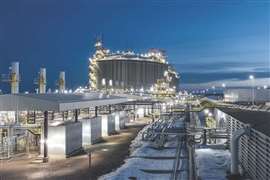Read this article in Français Deutsch Italiano Português Español
Archrock sees long-term growth as LNG and power demand boost U.S. gas compression
October 31, 2025
Company leaders cite infrastructure underinvestment, data center growth and LNG expansion as multi-year demand drivers
Archrock’s leadership sees a sustained growth cycle ahead for U.S. natural gas compression, fueled by rising LNG exports, accelerating power demand and underinvestment in energy infrastructure. Speaking during the company’s third-quarter 2025 earnings call, President and Chief Executive Officer Brad Childers and Chief Financial Officer Doug Arends said those structural trends are reshaping how operators deploy compression capacity across key basins.
 Archrock reported that revenue for the third quarter of 2023 was $253.4 million compared to $213.7 million in the third quarter of 2022. (Image: Archrock)
Archrock reported that revenue for the third quarter of 2023 was $253.4 million compared to $213.7 million in the third quarter of 2022. (Image: Archrock)
“The world is short of power,” Childers said. “That’s driving robust demand for LNG, and we’re also seeing growth in pipeline gas going to Mexico.” He added that Archrock’s compression fleet is increasingly supporting that export-driven expansion, along with growing gas use in industrial and power generation markets.
Compression demand strengthens across sectors
Childers said LNG export projects and data centers are driving new conversations with customers. “We’re seeing an acceleration in pipelines, LNG facilities, and final investment decisions, as well as data centers,” he said. “We’ve underinvested in infrastructure—both in pipes and in power—and that really has to catch up. The pressure we’re seeing on our business is excellent immediate, interim and long-term demand for our units.”
Archrock’s visibility into that demand is backed by solid utilization levels and customer stability. The company reported utilization at 96% in the third quarter, reflecting limited equipment availability industrywide.
Arends noted that equipment returns are historically low. “We really are seeing that at historically low levels,” he said. “Gas volumes are growing in the U.S., and there’s just a real lack of available equipment. I think our customers have started to understand there’s a real need to plan in advance for units.”
Longer contracts, steady pricing
With units staying on location longer than ever, Archrock’s compression fleet is becoming an increasingly embedded part of customer operations. “Our units are staying on location now greater than six years,” Childers said. “That reflects our focus on large horsepower installations and the midstream infrastructure position we now occupy.”
While Archrock’s standard contract terms remain three to five years, the company is seeing a shift toward longer agreements for large horsepower projects. “Because these are large capital investments, we’ve seen contract durations move to the higher end of the five-year range,” Childers said. “But we’re not necessarily trying to drive a shift — the relationships we have with our major customers and the master service agreements we hold with them provide long-term stability regardless of individual contract terms.”
That customer loyalty also supports continued pricing strength. “The vast bulk of our large strategic accounts include pricing mechanisms built into the agreements,” Childers said. “Either we reprice on an index, or we have a repricing opener. About 60 to 65% of our contracts are open for repricing annually, so in this high-utilization market, we expect to continue driving pricing in 2026.”
Technology investments improve margins
Archrock’s profitability continues to benefit from digital investments that improve field efficiency. Childers said technology adoption has become a key differentiator. “We’ve been investing in a very disciplined way over the years into technology — telemetry sensors on our equipment, and a big data engine that helps us prioritize customer service so we can maintain better runtime,” he said.
The system, he added, enhances both uptime and cost control. “Our mechanics are able to dispatch more efficiently, well equipped when they arrive on location. That creates a much more cost-effective approach to managing the operation,” Childers said. “We’re seeing the benefit of those investments in our numbers today, and we expect to continue to drive improvement.”
Archrock reported a 70.4% gross margin in the third quarter, excluding a tax benefit. “This business absolutely outperformed without the tax benefit,” Childers said. “That performance reflects pricing discipline and excellent cost management by our teams throughout the organization, especially in the field.”
CapEx outlook and supply chain limits
Childers said Archrock plans at least $250 million in capital expenditures for 2026, consistent with 2025 levels, to support continued fleet growth. “We see a lot of confidence in the multi-year growth scenario ahead deploying that level of CapEx to help support expanded infrastructure requirements for power and LNG exports,” he said.
Asked about supply chain constraints, Childers noted that lead times for new compressor engines remain extended. “The gating item for lead time is Caterpillar engines,” he said. “Those are in the 60-week time range now. There are some units available in the market, but with all this pressure for growth, those get used up quickly.”
Despite those challenges, he said Archrock’s position remains strong. “It’s interesting — in the past, I never would have thought a $250 million growth CapEx budget would be positioned as conservative,” he said. “We consider it consistent with prior high levels of investment. Customers are still in budget territory right now, so we’ll see how the rest of that shakes out.”
Inflation and cost management
Inflation remains a manageable factor, Childers said, with most input costs stabilizing. “Costs overall are trending at a normalized level of inflation — low single digits,” he said. “That’s what we’re seeing out of the OEMs for new equipment as well as for parts and materials.”
He said lubricant costs have eased with lower oil prices, while labor remains tight in certain regions. “The exception is labor costs, especially in the Permian, still running in the mid-single digits,” Childers said. “Labor is so short across the energy industry, particularly in that region. But we continue to manage those costs effectively.”
Arends said Archrock’s strong cash generation and balance sheet flexibility allow it to pursue multiple capital allocation strategies simultaneously. “We’re somewhat uniquely positioned to be able to do all of the above — deploy capital to our customers, grow our dividend, and execute on share repurchases,” he said.
The company’s leverage has declined to the low end of its target range, giving it room to fund both growth and shareholder returns. “We have both the luxury and the desire to do all of the above,” Arends said. “You should expect to see us continue to do that.”
Childers added that repurchases can provide additional value when market volatility undervalues the company’s stock. “The macro gives dislocation to our stock price,” he said. “Buying shares when the market isn’t valuing us appropriately can generate additional returns for our investors.”
Broader energy transition context
Childers framed Archrock’s growth outlook within the broader power and energy transition. “The amount of power that’s going to be required will drive increased natural gas production,” he said. “Only natural gas can respond as quickly as needed to deliver the feedstock required for the dense, high-demand power growth we see ahead.”
He added that compression remains the enabling technology for that supply growth. “Our primary goal right now is to deploy our capital to grow our compression infrastructure business to support that growth,” Childers said. “We’re excited about that investment opportunity.”
Archrock’s role, he emphasized, extends beyond traditional oil and gas infrastructure. “With so much of our natural gas going into LNG exports, we’re also participating in powering a greater world,” Childers said. “We’re proud of that.”
Archrock by the numbers
Fleet utilization: 96% in Q3 2025
Gross margin: 70.4%, excluding tax benefit
Capital expenditure guidance: Minimum $250 million for 2026
Average contract duration: Increasing toward five years for large horsepower units
Compression fleet on-site duration: Exceeds six years on average
Lead time for new engines: Approximately 60 weeks
MAGAZINE
NEWSLETTER

CONNECT WITH THE TEAM









